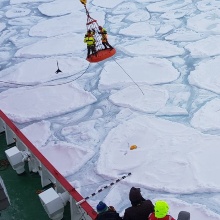The Southern Ocean of Antarctica and its seasonal ice cover are key components of the earth climate system. The ocean and the sea ice are affected by and even may amplify the climate change. The underside of the sea ice is a special habitat that is influenced by both the ice properties and those of the underlying water layer. In the ice-water boundary layer, a unique micro-ecosystem has developed that has adapted to the seasonal extreme changes in temperature and salinity. In the case of organic colonization of this layer, the so-called brine network with its special flow, temperature, radiation and nutrient conditions is an essential factor. The brine network forms the habitat of the so-called sympagic organisms, organisms living in the sea ice, such as bacteria, algae and single or multicellular small animals.
The ongoing climate change affects the area and thickness of the sea ice and thus also the brine network. As a result, multidimensional stress on the Antarctic micro-ecosystem is exercised, the consequences of which are still insufficiently assessable.
A new thrust for climate modeling is to include the sea ice biogeochemistry as a strong influencing factor, which highly depends on the porous sea ice microstructure. Changes within the physical and mechanical properties of sea ice due to atmospheric and oceanic changes are irrevocable connected to effects on the albedo, heat conductivity, the carbon cycle and related biogeochemical processes. The research project concerns about the small-scale simulation of physico-biogeochemical (P-BGC) processes coupled to the phase transformation of saline seawater to sea ice at the interface between ocean and atmosphere.

Andrea Thom
Dr.-Ing.Researcher

Tim Ricken
Univ.-Prof. Dr.-Ing.Head of Department




